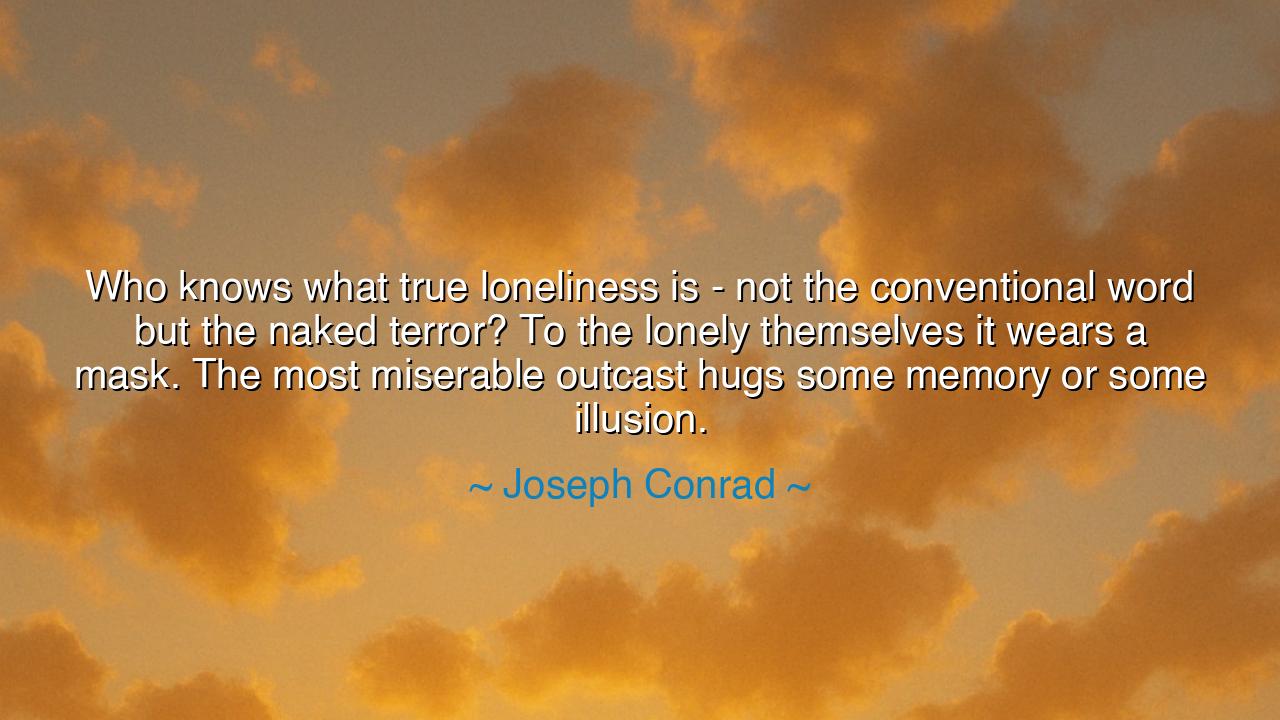
Who knows what true loneliness is - not the conventional word but
Who knows what true loneliness is - not the conventional word but the naked terror? To the lonely themselves it wears a mask. The most miserable outcast hugs some memory or some illusion.






"Who knows what true loneliness is—not the conventional word but the naked terror? To the lonely themselves it wears a mask. The most miserable outcast hugs some memory or some illusion." These words by Joseph Conrad cut through the illusions of the world, beckoning us to confront the darkness that lurks beneath the surface of loneliness. It is not merely the absence of company, nor the solitude that some may seek for peace or reflection. No, true loneliness is a profound terror, a soul-crushing void that cannot be easily understood or described. It is not a simple state of being alone; it is the profound isolation of the soul, separated from others by an impenetrable chasm of despair.
In the ancient world, the philosophers spoke of solitude in various forms. There was the solitude of the hermit, who chose to withdraw to find clarity and connection with the Divine. But there was also the loneliness of the wanderer, the one who was exiled or cast aside by the world. One such example is the story of Odysseus, whose journey back home was not merely one of adventure, but of separation from the very essence of his being. Throughout his odyssey, Odysseus faced loneliness, but it was not the kind we imagine. It was a loneliness that threatened to tear at his heart, to erode his sense of self. Even in the presence of others—whether the gods, his companions, or strangers—he felt alone, for the distance between his soul and the world was vast. Yet, in the end, his return to Ithaca was not only a return to home, but a return to himself. This is the loneliness Conrad speaks of—the naked terror that shrouds a man when he is utterly severed from the world.
Consider the story of Van Gogh, the great artist whose work transcended his time. He lived a life marked by extreme loneliness, often isolated in his small rooms, battling against his own mind, alienated from others by his intense passion for art. His genius was intertwined with a sense of isolation so profound that he sought solace in his work, yet even his art could not fully assuage the depths of his loneliness. Van Gogh's life is an example of Conrad’s naked terror—the terror that arises when one is consumed by their inner world, struggling to connect to the outside world, and finding only solitude in return. The loneliness that Van Gogh experienced was not simply a physical separation from others; it was the terrible separation from a sense of belonging, from the understanding and compassion of others.
The quote also reveals that for those who experience this kind of loneliness, it wears a mask. The most wretched outcast, Conrad writes, holds onto a memory or an illusion, as though clinging to a fragile thread of hope. This is the human condition in its most desperate form—when one is so lost in their own isolation that they begin to live in a world of half-truths, of illusions that mask the pain of true loneliness. It is a form of self-deception, a survival mechanism that allows the lonely soul to continue breathing. This is the tragedy of loneliness—it is often so consuming that it warps our sense of reality, causing us to cling to memories or fantasies that offer us comfort, but which are ultimately hollow.
There is a lesson here, one that we must carry with us as we navigate our own lives. Loneliness is a profound human experience, one that we must all face in some form. Yet, it is not to be feared or ignored. It is to be confronted, understood, and transcended. As Conrad so poignantly reveals, true loneliness cannot be escaped through distraction or illusion—it can only be healed through a deeper connection with the self and with others. We must be willing to look into the heart of our own solitude, to confront the naked terror within, and to seek the connections that will bridge the chasm of isolation.
Practical actions for those who experience such deep loneliness: first, do not seek to hide from it, but sit with it in stillness. Recognize that loneliness is not a permanent condition but a moment to be understood and transcended. Reach out to others, but do not expect that they will immediately heal your wound. True healing comes from within, through self-awareness and authentic connection. Find solace in the things that ground you—be it art, nature, or meditation. And most importantly, do not allow yourself to be deceived by illusions. Acknowledge the pain, embrace the truth, and know that in time, the light of connection will guide you out of the darkness.






AAdministratorAdministrator
Welcome, honored guests. Please leave a comment, we will respond soon